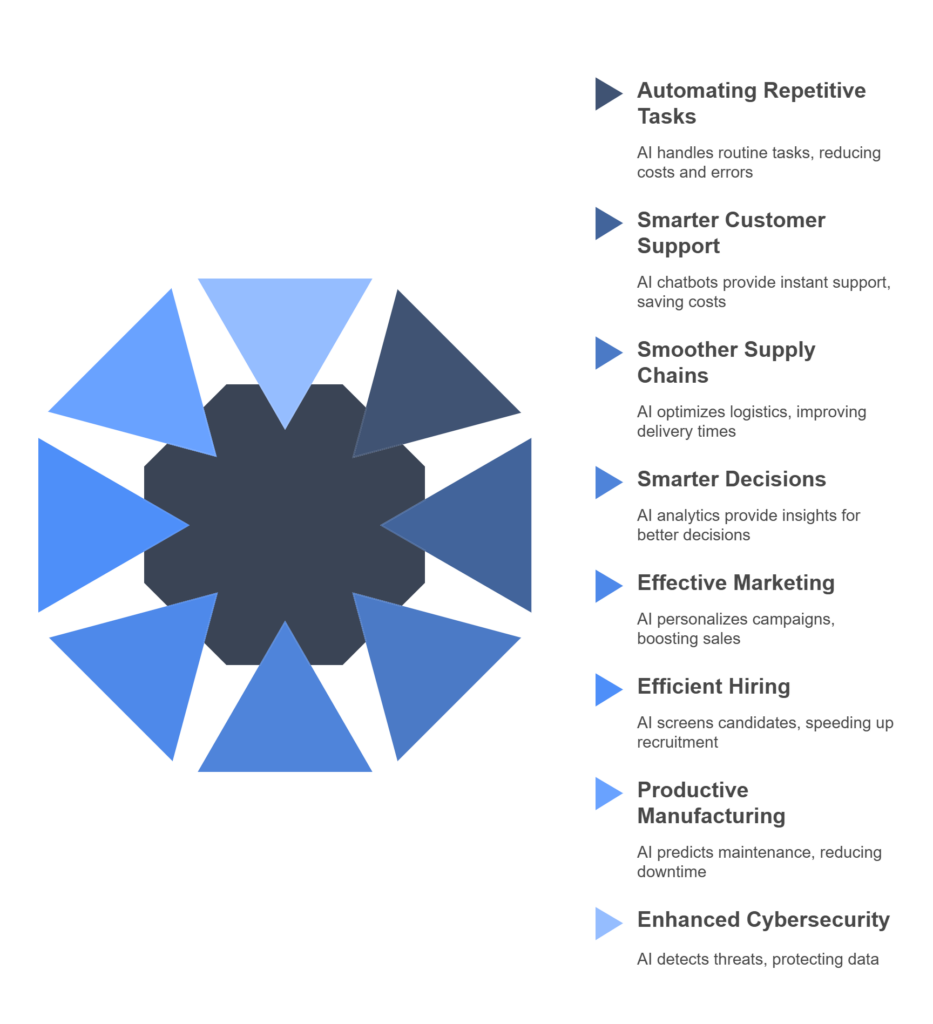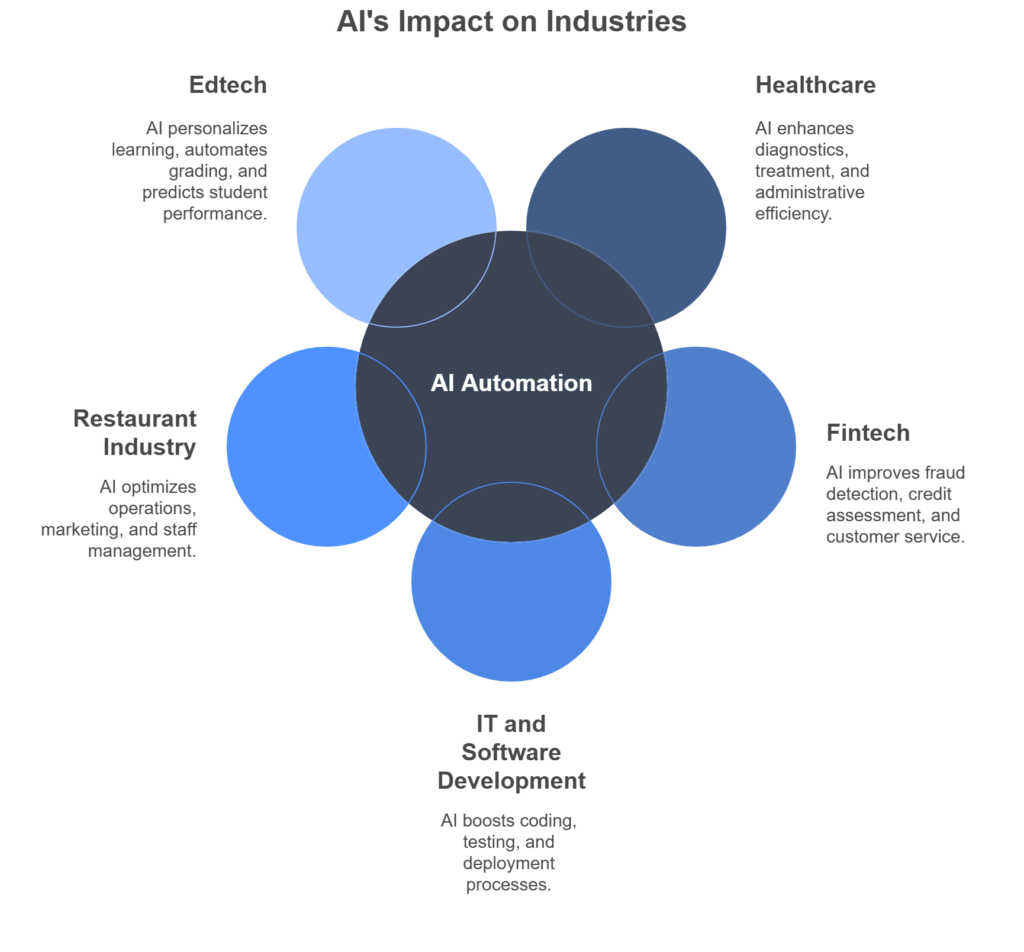AI is no longer just a shiny gadget or something out of sci-fi—it’s become a real workhorse behind the scenes in many industries. But how exactly does AI boost efficiency where it matters most? That’s what we’re going to explore, not in vague generalities but by digging into specific industries where AI is changing the day-to-day game.
From healthcare labs diagnosing diseases faster, to fintech firms spotting fraud before it happens, to restaurants speeding up your order without missing a beat, AI’s impact is huge—and measurable. Along the way, I’ll share real numbers and spotlight the actual AI tools that companies are using to get smarter and faster.
So if you’re curious how AI is making work easier in healthcare, fintech, IT, restaurants, and education, keep reading. There’s plenty to uncover—and it’s more practical (and exciting) than you might think.
How AI automation workflow is Improving Business Efficiency?

1. Automating the Repetitive Stuff
Think about the tasks that eat up so much of your day—data entry, invoice approvals, or answering the same customer questions over and over. These are perfect candidates for automation. AI-powered tools can handle these repetitive jobs faster and with fewer errors.
According to a McKinsey study, automating these routine tasks can cut operational costs by up to 20%. That means your team can spend more time on creative problem-solving and less time on tedious admin. Plus, automating tasks reduces human error, which often costs businesses big in the long run.
2. Smarter Customer Support
Customer service can make or break a business, but it’s often costly and time-consuming. AI chatbots and virtual assistants are changing the game by providing instant, 24/7 support for common queries. No more waiting on hold or delayed email responses.
In fact, companies using AI automation chatbots have reported a 30% drop in customer service costs and faster resolution times. Customers love getting quick answers, and businesses love saving money while freeing up human agents for complex issues. It’s a win-win.
3. Smoother Supply Chains
Supply chains can get complicated quickly. Predicting demand, managing inventory, and coordinating deliveries all involve juggling lots of moving parts. AI steps in by crunching huge amounts of data to forecast trends and optimize operations.
Businesses that have adopted AI automation in their supply chains report a 15% improvement in delivery times, meaning customers get their orders faster and warehouses avoid costly overstock or shortages. Especially in today’s world where speed and reliability are everything, this boost in efficiency is a game changer.
4. Smarter Decisions
Making business decisions is never easy—there’s so much data to sift through, and the stakes are high. AI-powered analytics tools help by quickly processing large datasets and pulling out insights humans might miss.
Gartner found that organizations using AI-driven analytics are twice as likely to speed up decision-making while improving accuracy, which naturally leads to better outcomes overall. When you have the right info at the right time, it’s easier to spot opportunities, avoid risks, and stay ahead of the competition. You don’t just work harder—you work smarter.
5. Marketing That Actually Works
Marketing today is all about personalization—reaching the right person with the right message at the right time. AI analyzes customer behaviors, preferences, and purchase history to tailor marketing campaigns that hit the mark.
Studies show AI-powered marketing can boost sales by about 20%. Plus, it cuts down wasted ad spend by focusing efforts on audiences most likely to convert. So instead of blasting generic ads, companies create smarter, more effective campaigns that truly connect.
6. Making Hiring Easier and Faster
Hiring the right talent is critical, but sifting through hundreds or thousands of resumes can be overwhelming. AI automation recruiting tools can screen candidates quickly, match qualifications to job descriptions, and even analyze video interviews to assess fit.
Businesses using AI automation for recruitment have slashed their time-to-hire by up to 50% and report higher-quality hires. It’s like having an extra pair of eyes that never get tired—helping HR focus on the human side rather than paperwork.
7. Manufacturing Made More Productive
In manufacturing, downtime can cost thousands every minute. AI-powered predictive maintenance solves this by continuously monitoring equipment health, spotting issues before they cause breakdowns.
The payoff? A 25% reduction in maintenance costs and longer machine lifespans. This means fewer interruptions, smoother production lines, and less money spent on emergency repairs. AI is like a watchful guardian keeping things running without costly surprises.
8. Keeping Data and Systems Safe
Cybersecurity is a huge concern for businesses of all sizes, and traditional defenses sometimes fall short against fast-evolving threats. AI steps in by spotting unusual activity and responding to threats faster than humans can.
Companies using AI-based security tools have seen incident response times cut by up to 30%. Faster detection means breaches get stopped before they cause real damage, protecting customer data and company reputation.
How AI automation is Impacting Efficiency Across Multiple Industries?

Artificial Intelligence is not one-size-fits-all. Its impact varies widely across industries, but the common thread is clear: AI boosts efficiency, saves time, reduces costs, and improves decision-making. Let’s explore how AI is reshaping five major industries with real stats and popular AI tools driving the change.
Healthcare
- Faster Diagnostics
AI-powered imaging tools like IBM Watson Health and Google’s DeepMind analyze medical images with high accuracy, reducing diagnosis time by up to 40%. - Predictive Analytics for Patient Outcomes
Tools like Tempus and Health Catalyst use AI to predict patient risks, helping reduce hospital readmissions by 15-20%. - Streamlined Administrative Tasks
AI-driven platforms such as Olive automate billing and claims processing, cutting administrative costs by over 30%. - Personalized Treatment Plans
AI analyzes patient data to recommend personalized treatments, improving outcomes and efficiency. Companies like PathAI claim to increase diagnostic accuracy by up to 25%. - Virtual Health Assistants
AI chatbots like Buoy Health provide symptom checking and triage 24/7, reducing unnecessary doctor visits by 20%.
Fintech
- Fraud Detection and Prevention
AI systems like Darktrace and Feedzai analyze transaction patterns in real-time, reducing fraud losses by over 40%. - Credit Risk Assessment
AI algorithms assess creditworthiness faster and more accurately than traditional methods. Zest AI reports a 20% increase in loan approval rates with reduced default risks. - Automated Customer Support
Chatbots like Kasisto’s KAI platform handle banking inquiries instantly, cutting customer service costs by up to 35%. - Algorithmic Trading
AI-driven trading platforms such as QuantConnect use machine learning to optimize trading strategies, improving returns by an average of 15%. - Regulatory Compliance
AI tools like Ascent automate compliance monitoring, reducing the time spent on regulatory tasks by 50%.
IT and Software Development
- Code Generation and Review
Tools like GitHub Copilot assist developers by suggesting code snippets and automating repetitive coding tasks, increasing productivity by up to 30%. - Automated Testing
AI-driven testing platforms such as Testim reduce manual testing time by 50% while improving defect detection rates. - DevOps Automation
Platforms like Harness use AI to automate continuous integration and deployment, shortening release cycles by up to 70%. - Incident Management
AI-based monitoring tools like Moogsoft detect and resolve IT incidents faster, reducing downtime by 40%. - Natural Language Processing for Documentation
AI tools like OpenAI’s GPT models help generate and maintain documentation, saving developers hours weekly.
Restaurant Industry
- Demand Forecasting
AI automation platforms such as Blue Yonder analyze historical data to optimize inventory and reduce food waste by up to 25%. - Automated Order Taking
Conversational AI assistants like McDonald’s AI-powered self-service kiosks speed up ordering, reducing wait times by 30%. - Personalized Marketing
AI-driven marketing tools like SevenRooms enable personalized offers based on customer preferences, boosting repeat visits by 15%. - Staff Scheduling
AI scheduling tools such as HotSchedules optimize staff shifts based on predicted demand, improving labor efficiency by 20%. - Robotics and Automation
Robotic kitchen assistants like Miso Robotics’ “Flippy” automate repetitive cooking tasks, increasing kitchen throughput by 30%.
Edtech
- Personalized Learning Paths
Platforms like DreamBox Learning adapt in real-time to student performance, improving engagement and learning outcomes by 30%. - Automated Grading
AI grading tools such as Gradescope reduce grading time by up to 50%, freeing educators for more interaction. - Virtual Tutors and Chatbots
AI tutors like Carnegie Learning provide personalized help, improving student retention by 20%. - Content Creation
Tools like Knewton generate adaptive course content tailored to learner needs, speeding up curriculum development by 40%. - Student Performance Prediction
AI platforms analyze data to predict at-risk students, allowing early intervention and reducing dropout rates by 15%.
The key takeaway?
AI automation isn’t some futuristic luxury reserved for tech giants—it’s the secret sauce quietly powering smarter, faster, leaner businesses today. It’s the invisible helper tackling the mundane so people can focus on what really drives value: creativity, strategy, and connection. No matter the industry, AI is opening new doors, rewriting the rules of efficiency, and giving those who embrace it a serious edge.
The real question isn’t if you should use AI—it’s how soon you can start.
